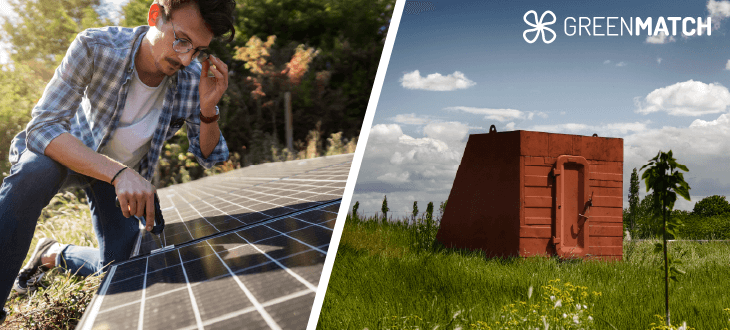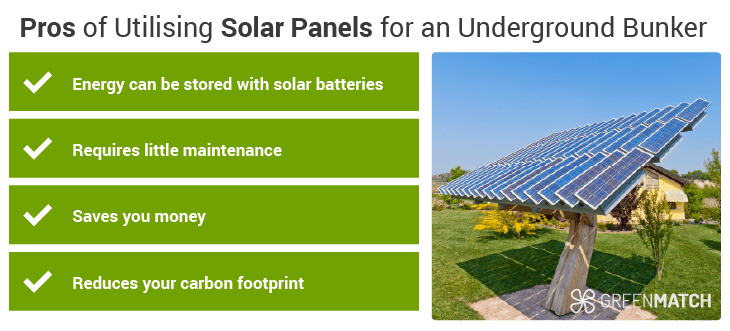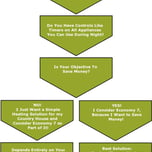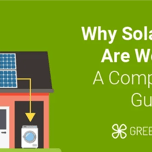Answer these simple questions and we will find you the BEST prices
Which type of solar quotes do you need?
It only takes 30 seconds
100% free with no obligation

Get up to 4 quotes by filling in only 1 quick form

Slash your energy bills by installing solar panels

For the average 2-3 bedroom house
- GreenMatch
- Solar Energy
- Solar Panels
- Solar Panels for Underground Bunker
Solar Panels for Underground Bunker (March 2025 Guide)


An underground bunker can serve as shelter during a disaster, or as a great way to live off-grid. Once you’ve got the proper permits to start living under the surface, it’s time to start thinking about things like water supply and a generator in your underground bunker.
That’s where solar panels come in. These solar-powered devices are used to provide electricity whenever the power goes out, or as a backup. Going solar comes with many advantages, such as independence from the electrical grid and a reduced carbon footprint.
But are solar panels worth it for your underground bunker? Let’s find out.
- Why Utilise Solar Panels for an Underground Bunker?
- Drawbacks of Using Solar Panels for an Underground Bunker
- How Much Will Solar Panels for Your Underground Bunker Cost?
- Do I Need Planning Permission for Solar Panels on my Underground Bunker?
- Summary: Is Solar Power for Your Underground Bunker Worth It?
- FAQs
Why Utilise Solar Panels for an Underground Bunker?

Solar panels have become a regular sight on many UK roofs. Although roofs are a popular option to place panels, they can easily be installed on other surfaces as well, such as the ground or the top of an underground bunker. Let’s take a look at some advantages of using solar panels for your underground bunker:
- Solar energy can be stored with solar batteries, meaning you can have power without having to rely on the grid in case of emergency.
- Solar panels require little maintenance, which means you don’t have to worry about repairs and maintenance once they’re installed.
- Solar panels can save you money in the long run if you use them regularly. After approximately 15 years of use, they’ll have paid for themselves.
- Going solar reduces your carbon footprint.
Drawbacks of Using Solar Panels for an Underground Bunker
While solar power can be highly beneficial for an underground bunker, there are some drawbacks to consider. Let’s have a look at some.
- Solar panels rely on sunlight. If your underground bunker catches a lot of shade, it may not meet your electricity needs.
- To properly use your solar panels in case of an emergency, the solar inverter still needs a power source. Therefore, an AC voltage must be generated from outside to ensure that the inverter can still run.
- While solar batteries usually last for 5 to 20 years, they can’t hold a charge forever. That means you can’t just keep saving power for years on end until an emergency happens.
- The initial financial impact of solar panels can be quite big. The bigger the solar system, the greater the investment.
How Much Will Solar Panels for Your Underground Bunker Cost?
Solar panels are a typical investment. They require an initial purchase, but you can earn your money back by saving on your energy bills in the long run. On average, a single solar panel costs £350-£500, but most underground bunkers require more than one panel to function properly without reliance on the grid.
There is also the cost of installation to consider. Generally, the more electricity your system can generate, the higher the initial installation cost will be. However, the savings will also be higher in the long run.
To save as much money as possible, we recommend comparing quotes from installers near you. GreenMatch can make this process easier by getting you up to 4 tailor-made offers, completely free of charge and obligation. Just hit the button underneath to get started and get the best price for your panels.
Fill in the form in just 1 minute
Do I Need Planning Permission for Solar Panels on my Underground Bunker?
Since 2008, planning permission for solar panels is often no longer necessary in the UK. However, since solar panels for an underground bunker are often not mounted to a building, some special rules may apply. Let’s look at them in detail.
If the panels are mounted within the grounds of your home, you won’t need planning permission for the first standalone solar installation. However, any installation after that will require planning permission. Furthermore, leaseholders may need to get approval from their landlord, freeholder or management company to install solar panels.
There are also other rules to keep in mind, such as:
- The installation can’t be higher than four metres.
- Your solar array (a string of solar panels that are wired together) can’t be more than 9 square metres, or 3 metres wide by 3 metres deep.
- The installation has to be at least 5 metres from the boundary of the property.
- Solar panels cannot be installed within the boundaries of a listed building or a scheduled monument.
- There are special rules for properties in a conservation area or a World Heritage Site. No part of the installation may be closer to a motorway bounding the residence than the section of the residence that is the closest to the motorway.
Summary: Is Solar Power for Your Underground Bunker Worth It?
By now, you should have a good idea of the pros and cons of using solar power for your underground bunker. While solar panels can be expensive at first and only work under certain conditions, they offer a lot of great advantages, especially in situations where you can’t rely on the electrical grid anymore.
Are solar panels for your underground bunker worth it, then? That depends on your situation. If your bunker catches a lot of shade, installing the panels most likely won’t lead to the results you desire. However, if you’re looking for a good way to generate power if push comes to shove and you can swallow the initial financial investment, solar panels are the way to go.
If you’re convinced that going solar is the right choice for your underground bunker, your next step should be to compare offers from local suppliers. By filling in our quotes form, we’ll connect you to up to 4 selected suppliers. Completely free, and with no obligation. Get started now by hitting the button underneath.
Fill in the form in just 1 minute
FAQ
There are several ways to take care of the power supply in your underground bunker. In case of emergency, most rely on a diesel or a solar generator. Solar panels especially can be a great sustainable option. Learn more about the advantages of using solar panels for your underground bunker here.
Making your underground bunker sustainable goes a long way. For example, you can make use of a composting toilet to avoid the use of water, and use solar panels to meet your energy needs. Read more about if going solar with your underground bunker is worth it here.
Solar panels rely on the availability of sunlight. When your underground bunker catches a lot of shade, the panels may not produce enough energy to meet your needs. Learn more about the drawbacks of using solar energy for an underground bunker here.

Nils is a content writer for GreenMatch with a background in SEO and blogging. Nils plays a major part in getting content ideas up and running. He also sometimes takes the pen in hand to write informational articles about renewable energy, sustainability and green technologies.
We strive to connect our customers with the right product and supplier. Would you like to be part of GreenMatch?

- Why Utilise Solar Panels for an Underground Bunker?
- Drawbacks of Using Solar Panels for an Underground Bunker
- How Much Will Solar Panels for Your Underground Bunker Cost?
- Do I Need Planning Permission for Solar Panels on my Underground Bunker?
- Summary: Is Solar Power for Your Underground Bunker Worth It?
- FAQs



